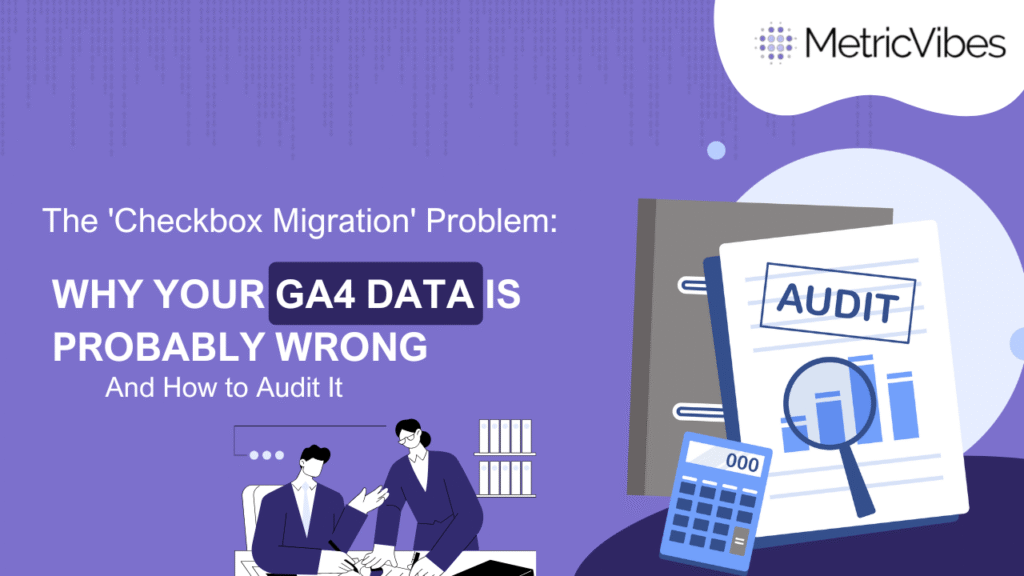The 'Checkbox Migration' Problem: Why Your GA4 Data is Probably Wrong (And How to Audit It).
The sunsetting of Universal Analytics (UA) and the mandatory migration to Google Analytics 4 (GA4) has left many scrambling to replicate existing setups.
The problem? Simply checking the boxes during migration doesn’t guarantee data accuracy. GA4’s event-based model represents a fundamental shift from UA’s session-based approach, leading to discrepancies if not handled carefully.
This post (GA4 migration data accuracy audit) details a practical, technical approach to auditing your GA4 implementation and ensuring your data is reliable.

Common Issues During GA4 Migrations (GA4 migration data accuracy audit)
One of the most common issues stemming from rushed migrations is mismatched conversion tracking. In UA, goals were often configured based on pageviews or events. GA4, however, treats everything as an event. This seemingly simple difference can cause significant data discrepancies, especially when migrating complex conversion funnels.
Another frequent problem arises from the handling of user identification and sessions. Differences in how GA4 calculates sessions compared to UA can lead to inaccurate traffic reports and skewed engagement metrics.
This discrepancy can be amplified if your marketing platforms, like Google Ads, aren’t correctly integrated with GA4, hindering accurate campaign performance measurement.
A Pragmatic GA4 Audit Approach
So, how do you systematically audit your GA4 setup and identify these lurking issues? Here’s a structured process focusing on data validation:
1. Baseline Your UA Data
Before diving into GA4, establish a baseline of your key metrics in UA. This will serve as your benchmark for comparison.
Focus on crucial business metrics, like conversion rates, customer lifetime value (CLTV), and customer acquisition cost (CAC). Export this data for future reference.
2. Map UA Goals to GA4 Events
Meticulously map each UA goal to its corresponding GA4 event. This is where many migrations falter.
Don’t just assume default events will suffice. Verify the event parameters match your UA setup, including custom dimensions and metrics.
3. Implement a Dual-Tagging Strategy
Run UA and GA4 in parallel for a period. This allows you to directly compare data and identify discrepancies.
Examine metrics side-by-side, looking for inconsistencies in conversion counts, user engagement, and traffic sources.
4. Deep Dive with a Custom Report
Create a custom report in GA4 that mirrors your key UA reports. This requires understanding the nuances of GA4’s event parameters and dimensions.
Here’s an example using BigQuery to access GA4 data and reconstruct a critical conversion funnel:
#standardSQL
SELECT
event_name,
COUNT(DISTINCT user_pseudo_id) AS unique_users
FROM
`your-ga4-project.analytics_xxxxxxxxx.events_*`
WHERE
_TABLE_SUFFIX BETWEEN FORMAT_DATE('%Y%m%d', DATE_SUB(CURRENT_DATE(), INTERVAL 7 DAY))
AND FORMAT_DATE('%Y%m%d', CURRENT_DATE())
AND event_name IN ('add_to_cart', 'begin_checkout', 'purchase')
GROUP BY 1
ORDER BY 1
This query allows you to analyze the user flow through your conversion funnel, comparing the numbers against your UA baseline.
By adapting this query for other key metrics, you can pinpoint discrepancies and understand the root causes.
5. Validate Data Integrity with Server-Side Tracking
Consider implementing server-side tracking, particularly if you’re dealing with sensitive data or require enhanced accuracy.
Server-side tracking can mitigate issues related to ad blockers and browser inconsistencies.
6. Leverage Data Layer Auditing Tools
Several tools can help validate your data layer implementation and identify potential issues.
This ensures consistent data capture across your website or app.
Conclusion
Migrating to GA4 is more than just a technical upgrade; it’s an opportunity to rethink your analytics strategy.
By meticulously auditing your implementation and understanding the nuances of GA4’s data model, you can unlock valuable insights and power data-driven decision-making.
While the initial effort might seem daunting, the long-term benefits of accurate, reliable data are undeniable.
The potential for deeper analysis using tools like BigQuery further enhances the value proposition of a well-implemented GA4 setup. However, be mindful of the potential learning curve and resource investment required for advanced analytics.
FAQ Section
GA4’s event-based model differs fundamentally from UA’s session-based approach. Discrepancies often arise from incorrect mapping of UA goals to GA4 events or variations in how sessions are calculated.
Aim for at least two to four weeks of parallel tracking to gather sufficient data for comparison and identify trends. This allows you to account for variations in user behavior and seasonal fluctuations.
Reach out for tailored analytics and personalization solutions for your business by us. Contact Here

